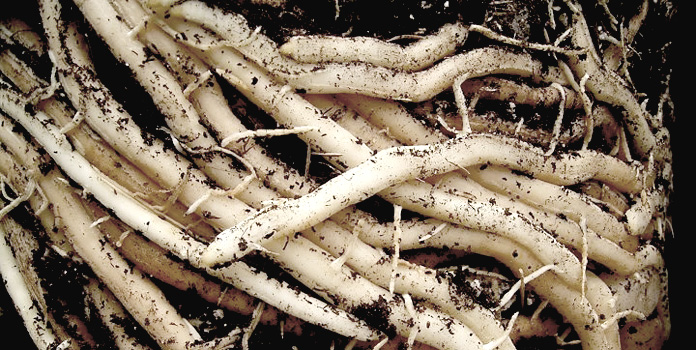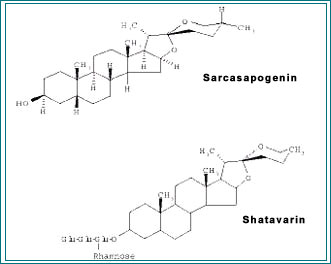Herbs A-B
Herbs C-D
Herbs E-M
Botanical Name : Asparagus racemosus
Other Names : Asparagus, Wild Asparagus, Satamuli.
Introduction
It belongs to the family of Liliaceae. Shatawari means ‚who possesses a hundred husbands. It is considered both a general tonic and a female reproductive tonic. Shatawari is the main Ayurvedic rejuvenative tonic for the female, as is Withania for the male. Shatawari is however, used for sexual debility and infertility in both sexes. It is also used for menopausal symptoms and to increase lactation.
Origin
This is found in the jungles around 8,000 feet altitude throughout India, especially Northern India.

Chemical composition/key active constituents
Steroidal saponins, known as shatavarins I-IV. Shatawarin I is the major glycoside with 3 glucose and rhamnose moieties attached to sarsasapogenin, whereas shatavarin-IV contains
Alkaloids, proteins, starch and tannin.
Isoflavones including 8-methoxy-5,6,4'-trihydroxyisoflavone 7-O-beta-D-glucopyranoside.
Asparagamine, a polycyclic alkaloid.
Racemosol, a cyclic hydrocarbon (9,10-dihydrophenanthrene).
Polysaccharides, mucilage is present in the roots.

Pharmacology
It is found to have lmmunostimulant property. It prevents post operative adhesions. Protective effect of Asparagus racemosus against myleosupressions induced by single and multiple doses of cyclophosphamide has also been studied in mice. It was found to have activity comparable to Lithium and Glucan. Galactogogue activity of Asparagus racemosus has been studied. Saponin mixture from total alcoholic extract of Shatavari was found to show uterine blocking activity, both spontaneous and induced by acetylcholine and Oxytocine. It is used in pregnancy for threatened abortion.
Remedies For
Galactagogue [Production of Milk], Immunomodulator, Aphrodisiac [Sexual Tonic], Mucilaginous, Refrigerant, Diuretic, Ant dysenteric, Nutritive Tonic, Demulcent, Antispasmodic, Adaptogen, Anti tussive, Antioxidant, Antibacterial, Cytoprotective, Anti-Oxytocic, Anti diarrhoeal.
References:
- Bhavmishra: Sartha Bhavprakash, (Ed.) Y. G. Dixt, Yervada Press, Poona.
- 2. Charaka Samhita, Nirnaya Sagar Press, Poona, (1941).
- 3. Vagbhatta: Sartha Vagbhatta, 4th Edn., G. K. Aryabhushana Mudranalaya, Poona, (1956).
- 4. Kirtikar, K. R. and B. D. Basu: Indian Medicinal Plants, Bishen Singh Mahendrapal Singh,Dehradun, (1985).
- 5. Chopra, R. N.: Indigenous Drugs of India, Academic Publishers, Calcutta.
- 6. Wealth of India, Vol. 1, Council of Scientific and Industrial Research, New Delhi, (1948).
Statements on this website is collected from online and offline references, they are an effective way of learning and sharing. With this knowledge, we can take control of our own health. These statements have not been evaluated by the FDA. Products and techniques mentioned here are not intended to diagnose, treat, cure or prevent any disease. However, when you give the body what it needs then the body can heal itself as God intended it to. We are bulk suppliers/Exporters of herbs, and raw materials this website is intend to provide option for various herbs buyers/importers/our customers, buy small Qty swiftly and pay for the product and shipping.